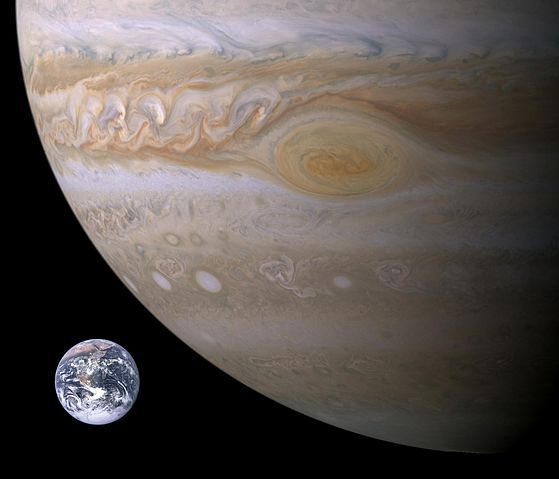 |
This is a file from the Wikimedia Commons. Information from its description page there is shown below.
Commons is a freely licensed media file repository. You can help.
|
Summary
| Description |
English: Rough visual comparison of Jupiter, Earth, and the Great Red Spot. Approximate scale is 44 km/px.
|
| Date |
2006-03-19 (first version); 2007-01-14 (last version) |
| Source |
Created from en:Image:The Earth seen from Apollo 17.jpg (taken from http://nssdc.gsfc.nasa.gov/imgcat/html/object_page/a17_h_148_22727.html and en:Image:PIA04866 modest.jpg (taken from http://photojournal.jpl.nasa.gov/catalog/PIA04866). Transferred from en.wikipedia
The image of Earth was taken by Apollo 17 on 7 December 1972. The image of Jupiter was taken by Cassini on 29 December 2000. |
| Author |
Brian0918 at en.wikipedia. Later version(s) were uploaded by Herbee at en.wikipedia. |
Permission
( Reusing this file) |
PD-USGOV-NASA.
|
Licensing
| Public domainPublic domainfalsefalse |
 |
This file is in the public domain because it was solely created by NASA. NASA copyright policy states that "NASA material is not protected by copyright unless noted". (See Template:PD-USGov, NASA copyright policy page or JPL Image Use Policy.) |
|
|
|
Warnings:
- Use of NASA logos, insignia and emblems are restricted per US law 14 CFR 1221.
- The NASA website hosts a large number of images from the Soviet/ Russian space agency, and other non-American space agencies. These are not necessarily in the public domain.
- Materials based on Hubble Space Telescope data may be copyrighted if they are not explicitly produced by the STScI. See also {{ PD-Hubble}} and {{ Cc-Hubble}}.
- The SOHO (ESA & NASA) joint project implies that all materials created by its probe are copyrighted and require permission for commercial non-educational use.
- Images featured on the Astronomy Picture of the Day (APOD) web site may be copyrighted.
|
File usage
The following pages on Schools Wikipedia link to this image (list may be incomplete):
This file contains additional information, probably added from the digital camera or scanner used to create or digitize it. If the file has been modified from its original state, some details may not fully reflect the modified file.
Wikipedia for Schools is one of SOS Childrens Villages' many educational projects. The world's largest orphan charity, SOS Childrens Villages brings a better life to more than 2 million people in 133 countries around the globe. Find out how you can help children in other countries.





